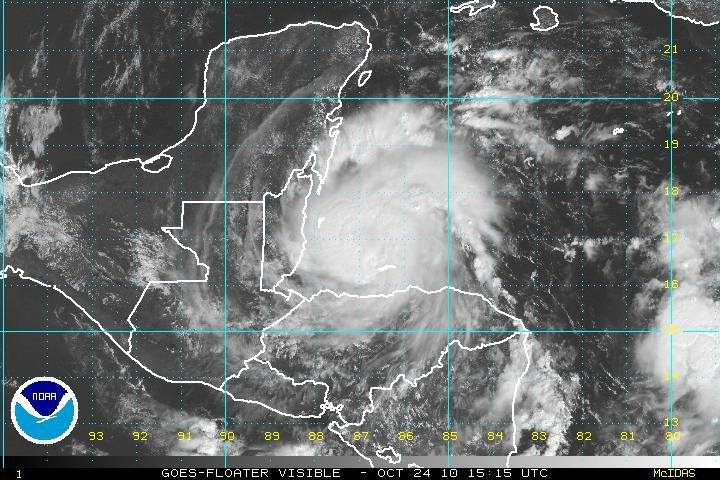Hurricane Richard anticipated to strengthen as it heads toward Belize, Yucatan Peninsula
Courtesy photo: NOAA via CNN Wire Service
The weather system known as Richard has intensified in the Caribbean from a tropical storm into a Category 1 hurricane, according to the CNN’s weather team. This image was taken on Oct. 24, at 5:15 a.m. CDT.
October 24, 2010
The storm known as Richard intensified in the Caribbean from a tropical storm into a Category 1 hurricane with maximum sustained winds of 85 miles per hour, the National Hurricane Center reported.
Hurricane Richard was located off the northeast coast of Honduras, moving west-northwest at 12 mph Sunday morning, the center said.
The storm is forecast to continue to strengthen, possibly becoming a Category 2 hurricane before it reaches the coast of Belize by Sunday evening. It is expected to weaken again once it moves inland.
The Belize National Emergency Management Organization said Sunday all public buses have stopped running and advised private cars to also get off the road.
It urged people living in Dangriga, a town in southern Belize, and in vulnerable parts of Belize City to seek shelter immediately. All vessels should remain in port, the organization also advised.
Belize is a small country in Central America popular among tourists for its pristine beaches and coral reefs.
Along with hurricane force winds, the main threat from the slow-moving Richard is the large amounts of rain it will dump on Belize and the Yucatan Peninsula. It is expected to produce three to six inches of rain with local amounts totaling 10 inches. These rains could produce life-threatening flash floods and mud slides, especially in the mountainous terrain.
Hurricane Richard is expected to weaken over land and reemerge in the Bay of Campeche as a tropical depression. Conditions are not favorable for redevelopment in the extreme southwestern Gulf of Mexico. The National Hurricane Center expects Richard to continue to dissipate into a remnant low.
“It is not a concern for the U.S.,” said John Cangialosi with the hurricane center. “Even if it does get into the southern Gulf of Mexico, a very strong wind sheer of that area will continue to weaken the system.”
A wind sheer is caused when winds go in different directions, causing the storm to weaken.
— CNN Meteorologist Monica O’Conner and CNN Radio’s Ninette Sosa contributed to this report.







